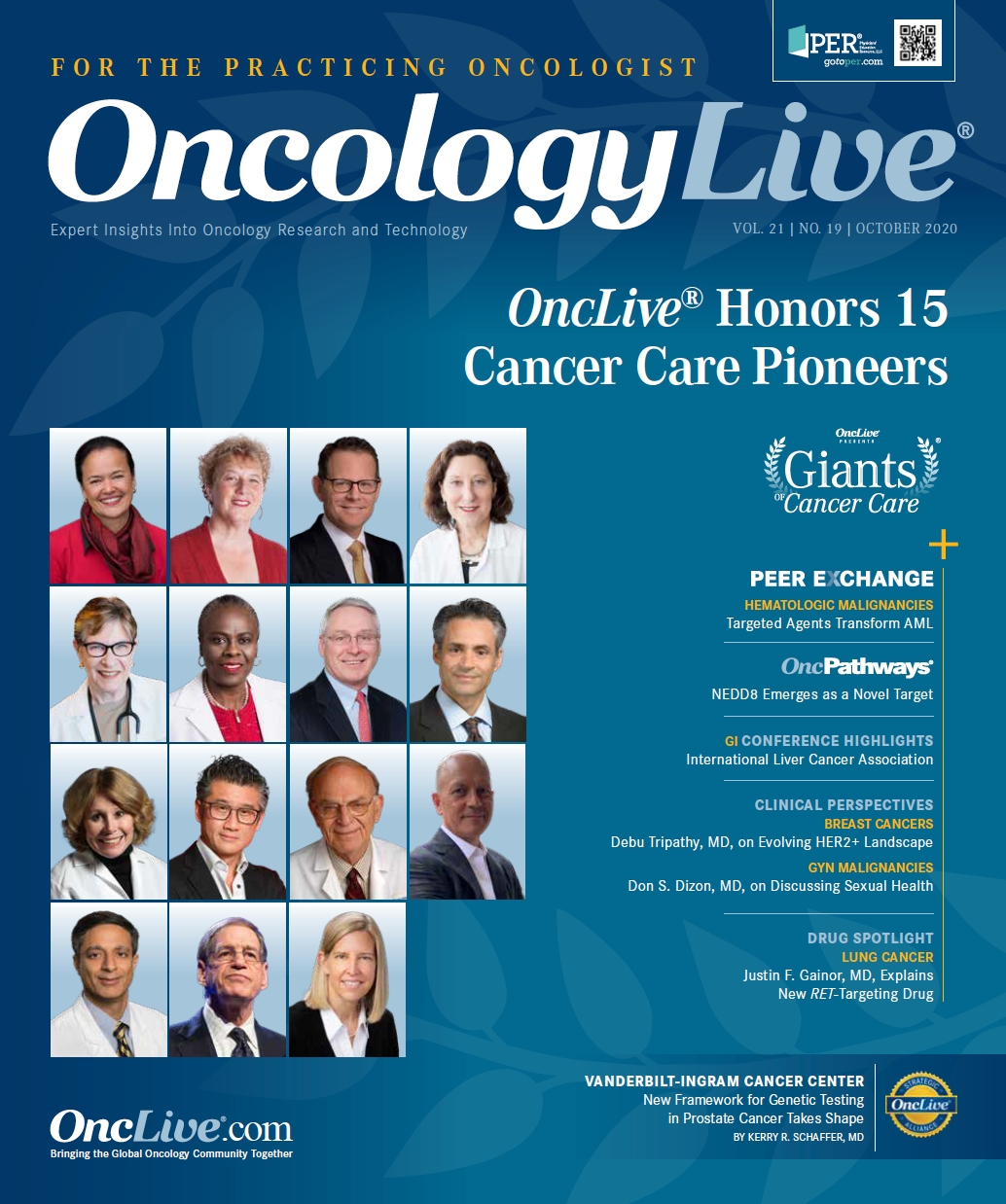Publication
Article
Oncology Live®
Targeted Therapy Options Transform AML Paradigm
Author(s):
An increased understanding of the biologic intricacies of acute myeloid leukemia has led to the identification of more than 100 driver mutations associated with the disease, opening the door for targeted therapies with clinically meaningful outcomes for patients who are not candidates for intensive chemo-therapy regimens.
An increased understanding of the biologic intricacies of acute myeloid leukemia (AML) has led to the identification of more than 100 driver mutations associated with the disease, opening the door for targeted therapies with clinically meaningful outcomes for patients who are not candidates for intensive chemotherapy regimens.1
AML is 1 of the most deadly and difficult cancers to treat. Chemotherapy remains the treatment mainstay for most patients; however, for those who experience an initial response, refractory disease is common.
Additionally, patients may not be candidates for induction chemotherapy because of fitness status, which includes factors such as age, performance status, and comorbidities.
During a recent OncLive Peer Exchange®, a panel of experts in leukemia discussed therapies that are reshaping the AML treatment landscape for some of the most vulnerable patient subsets.
They highlighted the use of the BCL-2 inhibitor venetoclax (Venclexta) in combinations as well as the emergence of the epigenetic drugs ivosidenib (Tibsovo) and enasidenib (Idhifa) for patients with IDH mutations. In addition to providing an overview of the clinical trial data for these drugs, they shared their insights into how they are using these agents in clinical practice and addressing treatment-related adverse events (AEs) to maximize outcomes.
Venetoclax: A New Standard of Care
In November 2018, the FDA granted accelerated approval to venetoclax for use in combination with the hypomethylating agents (HMAs) azacitidine (Vidaza) and decitabine (Dacogen) or with low-dose cytarabine (LDAC) for the treatment of newly diagnosed AML in adults aged at least 75 years or those with comorbidities that preclude the use of intensive induction chemotherapy.2 Approval was based on data from 2 open-label nonrandomized trials: M14-358 (NCT02203773), which assessed venetoclax in combination with azacitidine (n = 67) or decitabine (n = 13), and M14-387 (NCT02287233), which assessed venetoclax in combination with LDAC (n = 61), including in patients previously treated with an HMA for an antecedent hematologic disorder.
In these studies, 37% (n = 25) of those receiving venetoclax plus azacitidine achieved complete remission (CR), with a median of 5.5 months in remission; 54% (n = 7) of those receiving venetoclax plus decitabine achieved CR, with a median of 4.7 months in remission; and 21% (n = 13) of those receiving venetoclax plus LDAC achieved CR, with a median time in remission of 6 months.2
Daniel Pollyea, MD, MS

“Most of us who treat AML have been very excited these past couple of years to see what venetoclax can do for some patients,” Daniel Pollyea, MD, MS, said. However, he noted that approval was based on phase 2 data in noncomparative studies, which is why data in a randomized setting were highly anticipated. “Most of us who have worked in AML know this is a critical test, a time when a lot of prior therapies have not been able to surmount this challenge in a randomized setting,” he said. Pollyea proceeded to discuss the randomized, phase 3 VIALE-A (NCT02993523) and VIALE-C (NCT03069352) studies, which evaluated venetoclax in combination with azacitidine or LDAC, respectively.
VIALE-A Study
The VIALE-A study randomly assigned 431 treatment-naïve patients with confirmed AML who were ineligible for standard induction therapy because of age ( ≥ 75 years), comorbidities, or both 2:1 to azacitidine plus venetoclax (n = 286) or azacitidine plus placebo (n = 145).3 At a median follow-up of 20.5 months, the median overall survival (OS) was 14.7 months in the venetoclax arm and 9.6 months in the placebo arm (HR for death, 0.66; 95% CI, 0.52-0.85; P < .001). The venetoclax arm also had a significantly higher incidence of CR compared with the placebo arm (36.7% vs 17.9%; P < .001), including composite CR (CR or CR with incomplete hematologic recovery; 66.4% vs 28.3%; P < .001).
“Most of us who treat this disease were relieved and very happy to see the data for the venetoclax arm. [The agent] really performed very consistently with what we have come to expect, based on the phase 2 data. Those of us who have been using this agent frequently in the past year and a half, based on the approval, are reassured that this likely is the new standard of care in this setting,” Pollyea said. Throughout the discussion, the other panelists agreed that clinicians should consider venetoclax plus azacitidine the new standard of care for patients with AML who are not candidates for induction therapy because of age or comorbidities.
“We’ve been stuck in 28% to 30% response land for older patients with AML for decades. Now that’s not true. The 60% or greater response rates across cytogenetic groups, across molecular groups, are real. They happen. They’re quick. You don’t have to wait for 100 cycles of azacitidine to see those responses. It’s usually after 1 [cycle], sometimes 2,” Gail J. Roboz, MD, said.
Gail J. Roboz, MD

Based on the VIALE-A data, moderator Harry Paul Erba, MD, PhD, noted that “HMA monotherapy should not even be considered for our patients anymore.” He also explained that almost two-thirds of US patients, half of whom are aged at least 65 years, have historically not undergone AML treatment because of the relative lack of OS benefit seen with HMA monotherapy. In such untreated patients with AML, he said, the median survival is approximately 2 months, but with venetoclax plus azacitidine, older patients can have a median OS of 15 months. “[Subsequently], it’s not 15 months versus 9 or 10 months; it’s 15 months versus 2 months. We have to get away from the therapeutic nihilism in older patients with AML. In fact, the greatest survival benefit is seen in those over the age of 75 years,” he said.
Harry Paul Erba, MD, PhD

VIALE-C Study
The VIALE-C study randomly assigned 211 treatment-naïve patients with confirmed AML who were ineligible for standard induction therapy because of age ( ≥ 75 years), comorbidities, or both 2:1 to LDAC in combination with venetoclax (n= 143) or placebo (n= 68).4 In the primary analysis, at a median follow-up of 12 months, the venetoclax arm had a 25% reduction in the risk of death, with a median OS of 7.2 months compared with 4.1 months in the placebo arm, but the finding did not reach statistical significance (P = .11).5 However, after a median follow-up of 17.5 months, the venetoclax arm demonstrated a 30% reduction in the risk of death, with a median OS of 8.4 months versus 4.1 months in the placebo arm, a finding that did reach statistical significance (P = .04).4
“Based on a press release and some other information, [we had] the impression that the study would not be positive when compared with low-dose cytarabine alone. [But] when patients were followed for a little longer than the original planned analysis, there was a survival benefit,” Pollyea said. He noted several reasons why the VIALE-C study may have shown less OS benefit than the VIALE-A study, such as the inclusion of a more challenging patient population. He noted that more than 33% of patients in the study had previously received an HMA for a myelodysplastic syndrome, and such patients had been excluded from the VIALE-A study. Regardless, Pollyea said the most important takeaway is that this regimen provides another treatment option. “For us in the leukemia world, there’s no way that’s not a good thing.”
Roboz, who was a coauthor of the VIALE-C study, said that although the findings are overshadowed by the azacitidine data, LDAC plus venetoclax is still a useful regimen. “The reason you’re not seeing the benefit is more because of disadvantageous study design with respect to the hazard ratio and statistics rather than because the regimen doesn’t have any benefit,” she said. Although venetoclax plus azacitidine is taking its place as the new standard of care, Roboz said she would still try LDAC plus venetoclax for patients, including those who are unlikely to benefit from the addition of more HMAs.
Venetoclax Safety Issues
The most common AEs (≥ 20%) observed with venetoclax in combination with azacitidine, decitabine, or LDAC in clinical trials were nausea, diarrhea, thrombocytopenia, constipation, neutropenia, febrile neutropenia, fatigue, vomiting, peripheral edema, pyrexia, pneumonia, dyspnea, hemorrhage, anemia, rash, abdominal pain, sepsis, back pain, myalgia, dizziness, cough, oropharyngeal pain, and hypotension. In the VIALE studies, the most frequently reported AEs were hematologic events (Table 1).3,4
Table 1. Prevalence of Hematologic AEs Observed With Venetoclax in the VIALE Studies3,4
Of note, venetoclax has a warning regarding tumor lysis syndrome; however, it appears to be uncommon in patients with AML. “It’s important to watch and to be careful, especially with the first few doses, but it’s much less common than what you would see with chronic lymphocytic leukemia,” Amir Fathi, MD, said.
Amir Fathi, MD

He noted that his greatest concern with venetoclax is the lack of consistency in how it is used in combination with HMAs in community practices. “I can’t tell you how many patients we’ve admitted to our ICUs [intensive care units] who have been treated in the community with HMA/venetoclax cycle after cycle after cycle and end up with severe marrow suppression, infections, and bleeding complications,” he said.
Fathi added that although some nuances in treatment will always exist, a more consistent approach is needed.
He said that in his practice, he starts with 4 weeks of venetoclax plus the HMA and then conducts a bone marrow biopsy to assess blast level. “If the marrow is empty, I allow count recovery [by holding venetoclax] and then resume. If it is full of blasts, I go with the second cycle,” he said. If blast depletion occurs repeatedly, Fathi added, the intensity of treatment should be decreased, noting that he usually reduces treatment to 2 or 3 weeks in such cases.
Additionally, he said clinicians must consider concurrent medications, particularly the azoles (eg, isavuconazole sulfate [Cresemba], voriconazole [Vfend], and posaconazole [Noxafil]). “You have to reduce the dose…otherwise you’re going to get in trouble with marrow suppression,” he said.
Roboz agreed with Fathi: “Please don’t be on day 60 of venetoclax without a bone marrow biopsy. Please don’t add an antifungal. If you’re going to add it, you’ve got to down the dose. At least certain basic principles must be absolutely applied, even if the subtleties of exactly what day you do the marrow and exactly which antifungal can’t be mandated.”
Targeting IDH Mutations
Approximately 20% of patients with AML have IDH mutations, with IDH1 mutations found in 6% to 16% of patients and IDH2 mutations found in 8% to 19%.6 These mutations are associated with a poor prognosis.6 Before treatments targeting IDH mutations were developed, “we [had] been pummeling [such patients] for decades with lots of different chemotherapy combinations without success,” Roboz said.
The emergence of IDH inhibitors enables clinicians to treat patients with IDH mutations with a single-agent regimen that provides high response rates and durable remissions, often lasting 6 to 12 months, she said. Based on such findings in the relapsed setting, the IDH inhibitors ivosidenib, a potent IDH1 inhibitor, and enasidenib, a potent IDH2 inhibitor, have also been explored as treatments in the frontline setting. Both agents are currently FDA approved for adult patients with relapsed/refractory AML, with ivosidenib also approved as a first-line treatment.7,8 Several studies are currently examining these agents in combination treatments, including with venetoclax and azacitidine. An advantage of both agents is that they are taken orally, which may be particularly beneficial for some patients during the ongoing coronavirus disease 2019 (COVID-19) pandemic.
Ivosidenib
Ivosidenib received FDA approval in May 2019 as a first-line treatment in patients with a susceptible IDH1 mutation, as detected by an FDA-approved test, who are not candidates for intensive induction chemotherapy because of age ( ≥ 75 years) or comorbidities.9 Approval was based on the open-label, single-arm, multicenter AG120-C-001 study (NCT02074839), which included 28 such patients. Of these patients, 12 (42.9%) achieved CR and CR with partial hematologic recovery (CRh) and 7 of the 17 transfusion-dependent patients (41.2%) achieved transfusion independence lasting at least 8 weeks.9
“These are patients who might not actually have been offered anything. They were the patients who are older and may have fallen into the nihilism trap. And yet here they are in a durable remission,” Roboz said.
Adding the HMA azacitidine to ivosidenib has also shown benefit. In a phase 1b/2 study (NCT02677922), the combination resulted in a high rate of clinical response with molecular remissions in patients ineligible for intensive chemotherapy.10 Investigators are assessing the combination for such patients in the phase 3 AGILE trial (NCT03173248).11 Participants are being randomly assigned 1:1 to ivosidenib 500 mg daily plus azacitidine 75 mg/m2 subcutaneously or intravenously for 7 days in 28-day cycles or to matched placebo plus azacitidine.11 The study is enrolling patients globally; however, enrollment has slowed because of COVID-19, and it is now expected to be completed in 2021.12
Further, investigators are conducting a phase 1/2 study (NCT03471260) of ivosidenib in combination with venetoclax with or without concomitant azacitidine in patients with treatment-naïve (n = 5) and relapsed (n = 9) IDH1-mutated AML.13
Roboz said venetoclax has demonstrated efficacy in both IDH subgroups, making it an appealing partner for IDH-directed combination therapy. In the study, the composite CR (CR plus CR with incomplete hematologic recovery plus CRh) was 100% in the treatment-naïve cohort and 75% in the relapsed/refractory cohort.13 After a median follow-up of 3.5 months, the median OS was not reached in treatment-naïve patients and was 9.7 months in the patients with relapsed/ refractory disease.13
Enasidenib
Erba said that presentations by Courtney D. DiNardo, MD, MSCE, on phase 2 trial data involving azacitidine alone versus azacitidine plus enasidenib were among the most interesting studies at the European Hematology Association and American Society of Clinical Oncology conferences.
The study (NCT02677922) included 101 patients with newly diagnosed IDH2-mutated AML who were randomly assigned 2:1 to the azacitidine/enasidenib combination (n = 68) or azacitidine monotherapy (n = 33).14 Both cohorts had a median OS of 22 months; however, the combination therapy arm had improvements in event-free survival (17.2 months vs 10.8 months), overall response rates (71% vs 42%), median duration of response (24.1 months vs 12.1 months), and complete response rates (53% vs 12%).14
Fathi warned about drawing conclusions about the OS data from this study because they are from the phase 2 portion of an open-label phase 1/2 randomized trial and not from a phase 3 randomized trial such as the VIALE studies. He noted this is an important consideration when thinking about combination therapies (ie, venetoclax/HMAs vs IDH inhibitor/HMAs). His preference is to use venetoclax/HMA in younger patients and those who can tolerate the combination, reserving the IDH inhibitors as a subsequent treatment option. “However, if I think a patient may tolerate the HMA/IDH inhibitor better, I generally go with that. I like to have options so that I can prolong a patient’s survival with sequential therapy. There are no data, obviously, to guide that, but that’s just been my general approach with these patients,” he said.
After the Peer Exchange, Bristol Myers Squibb, the manufacturer of enasidenib, reported a further development with the drug.15 Enasidenib plus best supportive care (BSC) was not found to significantly improve OS in patients with IDH2-mutated relapsed/refractory AML in the phase 3 IDHENTIFY trial (NCT02577406), thereby failing to meet the study’s primary end point.15 In the study, enasidenib plus BSC was compared with conventional care regimens, including BSC alone, azacitidine plus BSC, LDAC plus BSC, and intermediate-dose cytarabine plus BSC. A full evaluation of the IDHENTIFY data is ongoing and is expected to be presented at a future medical meeting.15
IDH Inhibitor Safety
The most common AEs observed with ivosidenib and enasidenib in clinical trials are listed in Table 2.7,8 The panelists said they do not undertake dose adjustments when they observe hyperbilirubinemia from inhibition of UGT1A1 in patients treated with enasidenib. “It’s a measure of patient adherence,” Mark J. Levis, MD, PhD, said. Roboz agreed and explained that stopping therapy in some cases would be a mistake.
Table 2. Most Common AEs ( ≥ 30%), Boxed Warning Associated With Ivosidenib and Enasidenib7,8

They also noted that QT prolongation has been observed with ivosidenib. Although uncommon, Guillain-Barré syndrome was identified in some of these cases. “In our phase 1 experience, Guillain-Barré [occurred] in 2 of about 250 patients,” Erba said. Levis said he has also seen such a case; thus, clinicians should be aware of this association.
Although their AE profiles are a bit different, a potential AE that both IDH inhibitors share is differentiation syndrome, a potentially life-threatening complication that is noted in a boxed warning in their prescribing information.7,8 “If you look at study after study with IDH inhibitors, either as monotherapy or a combination with induction for HMA, you’ll see approximately 12% to 20% of patients getting differentiation syndrome,” Fathi said, noting it is a difficult entity to tease out because it has a vague constellation of symptoms, many of which may be associated with other causes. He explained that common symptoms seen in patients with IDH-associated differentiation syndrome include unexplained fever, respiratory issues, pleural effusions, pericardial effusions, rash, mild azotemia, bone pain, and adenopathy.
Mark J. Levis, MD, PhD

Importantly, although clinicians should try to rule out secondary causes of these symptoms, if they cannot do so easily or quickly, they should treat the patients as though they have differentiation syndrome, Fathi explained. “[In such cases], initiation of steroids is important because these conditions can escalate,” he said, recommending dexamethasone 10 mg twice daily for such patients. “Then once patients get better, and they should if it is differentiation syndrome, there should be a tapering down of the dose over time,” he said.
Unlike the differentiation syndrome observed in patients with acute promyelocytic leukemia treated with all-trans retinoic acid, IDH inhibitor-related differentiation syndrome in patients with AML is delayed. “The median time of loss was around 12 weeks. So anywhere between 10 days and 6 months, you can potentially get it. If you stop treatment and resume it later, you can get recurrent episodes of differentiation syndrome,” Fathi said. He concluded by stating that the condition sometimes occurs with other AEs, including leukocytosis, disseminated intravascular coagulation, and tumor lysis syndrome, and that such cases will require additional measures, such as the addition of hydroxyurea in the setting of concurrent leukocytosis.
References:
- Papaemmanuil E, Gerstung M, Bullinger L, et al. Genomic classification and prognosis in acute myeloid leukemia. N Engl J Med. 2016;374(23):2209-2221. doi:10.1056/NEJMoa1516192
- FDA approves venetoclax in combination for AML in adults. FDA. Updated December 14, 2018. Accessed September 8, 2020. https://bit.ly/3h4xQPR
- DiNardo CD, Jonas BA, Pullarkat V, et al. Azacitidine and venetoclax in previously untreated acute myeloid leukemia. N Engl J Med. 2020;383(7):617-629. doi:10.1056/NEJMoa2012971
- Wei AH, Montesinos P, Ivanov V, et al. A phase 3 study of venetoclax plus low-dose cytarabine in previously untreated older patients with acute myeloid leukemia (VIALE-C): a 6-month update. Presented at: European Hematology Association 25th Virtual Congress; June 11-14, 2020. Abstract S136. Accessed September 8, 2020. https://bit.ly/3hcVRV8
- AbbVie provides update from phase 3 study evaluating Venclexta (venetoclax) in combination with low-dose cytarabine in newly-diagnosed patients with acute myeloid leukemia (AML). News release. AbbVie. February 28, 2020. Accessed September 8, 2020. https://bit.ly/3anl1gu
- DiNardo CD, Ravandi F, Agresta S, et al. Characteristics, clinical outcome, and prognostic significance of IDH mutations in AML. Am J Hematol. 2015;90(8):732-736. doi:10.1002/ajh.24072
- Tibsovo. Prescribing information. Agios Pharmaceuticals Inc; 2019. Accessed September 8, 2020. https://bit.ly/3bFV2TB
- Idhifa. Prescribing information. Agios Pharmaceuticals Inc; 2019. Accessed September 8, 2020. https://www.accessdata.fda.gov/drugsatfda_docs/label/2019/209606s002lbl.pdf
- FDA approves ivosidenib as first-line treatment for AML with IDH1 mutation. FDA. Updated May 3, 2019. Accessed September 8, 2020. https://bit.ly/3gZHoeV
- Daigle SR, Choe S, Quek L, et al. High rate of IDH1 mutation clearance and measurable residual disease negativity in patients with IDH1-mutant newly diagnosed acute myeloid leukemia treated with ivosidenib (AG-120) and azacitidine. Blood. 2019;134(suppl 1):2706. doi:10.1182/blood-2019-122590
- Fernandez PM, Recher C, Doronin V, et al. AGILE: a phase 3, multicenter, double-blind, randomized, placebo-controlled study of ivosidenib in combination with azacitidine in adult patients with previously untreated acute myeloid leukemia with an IDH1 mutation. Blood. 2019;134(suppl 1):2593. doi:10.1182/blood-2019-123045
- Bell J. Agios drops as COVID-19 takes a toll on drug studies. BioPharma Dive. May 1, 2020. Accessed September 8, 2020. https://bit.ly/2ETUmhz
- Lachowiez CA, Borthakur G, Loghavi S, et al. Phase Ib/II study of the IDH1-mutant inhibitor ivosidenib with the BCL2 inhibitor venetoclax +/- azacitidine in IDH1-mutated hematologic malignancies. J Clin Oncol. 2020;38(suppl 15):7500. doi:10.1200/JCO.2020.38.15_suppl.7500
- Dinardo CD, Schuh AC, Stein EM, et al. Effect of enasidenib (ENA) plus azacitidine (AZA) on complete remission and overall response versus AZA monotherapy in mutant-IDH2 (mIDH2) newly diagnosed acute myeloid leukemia (ND-AML). J Clin Oncol. 2020;38(suppl 15):7501. doi:10.1200/JCO.2020.38.15_suppl.7501
- Bristol Myers Squibb provides update on phase 3 IDHENTIFY trial in patients with relapsed or refractory acute myeloid leukemia. News release. Bristol Myers Squibb. August 25, 2020. Accessed September 8, 2020. https://bit.ly/2Yz3xuj
























%20(2)%201-Recovered-Recovered-Recovered-Recovered-Recovered-Recovered-Recovered-Recovered-Recovered-Recovered-Recovered-Recovered-Recovered-Recovered-Recovered-Recovered-Recovered.jpg?fit=crop&auto=format)
%20(2)%201-Recovered-Recovered-Recovered-Recovered-Recovered-Recovered-Recovered-Recovered-Recovered-Recovered-Recovered-Recovered-Recovered-Recovered-Recovered-Recovered-Recovered.jpg?fit=crop&auto=format)
